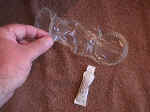
|
|
Female Condom
Female condoms can be very effective in preventing pregnancy and providing reasonable protection against some sexually transmitted diseases.
Each female condom is individually packaged and pre-lubricated. It is made out of plastic, not latex, so it is particularly useful for women and men with latex allergies. Each package contains an extra small tube of lubricant.
After removal of the condom from its' package, the inner ring is compressed into an oval shape. The inner ring is then inserted deeply into the vagina, so that it encircles the cervix. With proper positioning, the exterior ring will cover the vulva and remain outside the vagina.
During intercourse, the penis is inserted through the outer ring into the vagina. It is a good idea to hold the outer ring in place while the penis is initially inserted.
After intercourse, the outside ring is twisted to seal the semen inside the condom. Then the condom can be gently pulled straight out. It should be discarded in a trash container and not flushed, as it may clog the toilet.
Although pre-lubricated, women may find they need additional lubrication. Some women can feel the condom inside the vagina and others cannot. Extra lubrication can be helpful if this sensation is a distraction.
Some women find that intercourse while using the female condom produces distracting sounds. In this case, the use of additional lubricant can be helpful in silencing the noise.
Additional spermicide (cream, foam or jelly) can be used safely with the female condom, although the degree to which this provides additional contraceptive effect is unknown. If extra spermicide is to be used, it is most likely to be helpful if placed in the vagina prior to insertion of the female condom.
The effectiveness of the female condom in preventing pregnancy is roughly the same as the use of a diaphragm. When used carefully and consistently with each episode of intercourse, there will be about 5 failures per 100 women per year (95% effective). When all women who use this method are evaluated, including those whose use is not always careful and not necessarily consistent, the annual failure rate (pregnancy rate) is about 20%.
Bureau of Medicine and
Surgery |
Operational Obstetrics
& Gynecology - 2nd Edition |